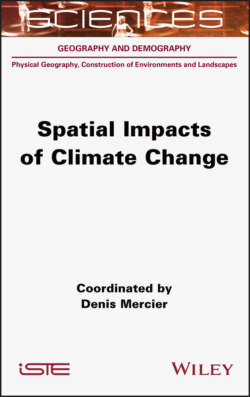Читать книгу Spatial Impacts of Climate Change - Denis Mercier - Страница 33
2.5. Consequences of the melting cryosphere 2.5.1. On a global scale: rising sea levels
ОглавлениеAt this scale, the most important consequence of the melting of the cryosphere is sea level rise. In addition to the thermal expansion of the oceans, the main sources of this sea level rise are the melting of the Greenland ice sheet and the Antarctic ice sheet, the contribution of mountain glaciers and permafrost. It was 18 cm during the 20th Century, and the various IPCC scenarios envisage a rise of around 60 to 100 cm by the end of the 21st Century (IPCC 2019).
However, we should not think in terms of this deadline alone, but rather that the rise of the seas and oceans will continue over the coming centuries as part of the melting of continental ice that has begun since the beginning of the Holocene interglacial period in which we live.
Thus, an increase (rise) of 5 m will surely be recorded by 2300. The consequences for low-lying coastal areas such as estuaries, tidal marshes, deltas, etc. will affect the economic activities and human occupation of millions of citizens (see Chapter 4).
A recent assessment by Zemp et al. (2019) shows that glaciers alone lost more than 9 billion tons of ice between 1961 and 2016, raising water levels by 27 millimeters (see Figure 2.13).
With more than 3,000 Gt, the Alaska Glaciers (ALA) have contributed the most to sea level rise. The glaciers of Southwest Asia (ASW, green circle) were the only ones to record an increase in mass.
Glaciers in the European Alps, the Caucasus mountain range and New Zealand have also suffered significant ice loss. However, because of their relatively small glacial areas, they have played only a minor role in sea-level rise (Zemp et al. 2019).
Figure 2.13. Regional share of glaciers in sea-level rise from 1961 to 2016. The cumulative change in regional and global glacier mass (in gigatons, 1 Gt = 1,000,000,000 tons) corresponds to the size of the circles. The synthesis is based on 19,000 glaciers worldwide
(source: modified from Zemp et al. 2019).
Fora color version of this figure, see www.iste.co.uk/mercier/climate.zip
2.5.2. Regionally: paraglacial risks
At the scale of mountain ranges, the melting of glaciers and areas with permafrost has consequences for the paraglacial sedimentary cascade (see Chapter 5), periglacial dynamics (see Chapter 6), hydrology of Arctic rivers (see Chapter 7), and water supply in Central Asia (see Chapter 9).
On the other hand, the shrinking of glaciers also brings with it paraglacial risks for the populations living on the margins of these glaciated areas.
Figure 2.14. Paraglacial hazards induced by melting glaciers. For a color version of this figure, see www.iste.co.uk/mercier/climate.zip
(source: design D. Mercier; drawing F. Bonnaud, Sorbonne University, 2019)
Glacier melt induces the formation of lakes in the immediate periphery of glaciers, with meltwater often retained by natural dams formed by frontal moraines (see Figure 2.14). This glacial melting and these lakes feed rivers that flow downstream in valleys to the seas and oceans. When glaciers calve and large areas of ice fall into lakes (see Figure 2.14, step 1a), waves can form (see Figure 2.14, step 2) and breach the frontal moraines (see Figure 2.14, step 3). The flows then become torrential with a mixture of water and sediment, resulting in highly turbid, torrential lava flows that can affect localized issues at the periphery of the flow area (see Figure 2.14, steps 4a and 4b). As a result, infrastructure such as roads, bridges, airstrips, hangars, dykes, houses, etc., can be damaged by these lava flows (see Figure 2.14, Zone B).
The problem of draining water pockets remains a threat in the Alps since the dramatic accident in Saint-Gervais in 1892, which claimed 175 victims downstream from the Tête Rousse glacier. These Glacial Lake Outburst Floods (GLOFs) are present in many mountains, in the Andes, in the Himalayas2 (Westoby et al. 2014).
In Iceland, these floods, called jokulhlaups (literally “the running glacier”) are associated with the melting of glaciers under the effect of global warming but can also be exacerbated by sub-glacial volcanic activity. In North America, the Alaska Climate Adaptation Science Center (AK CASC) is funding research on the Mendenhall Glacier to better understand its dynamics and the risks induced by its flash floods in order to model its dynamics and predict flooding by monitoring, and among other things, the current water level in the lake, its spatial extent and its bathymetry.
The melting of glaciers also induces landslides on the slopes because the pressure exerted during the glacial sequence is replaced by a decompression of the walls (Mercier 2016). Thus, rock volumes can move down the slopes and end their course in proglacial lakes (see Figure 2.14, step 1b), potentially generating waves, breaches and torrential lava, or directly affecting the infrastructures below the uplift zones. Melting permafrost in the walls, or increased rainfall, may also cause debris flows that may also end their course in the proglacial lake, leading to the same chain of events (see Figure 2.14, step 1c). These gravitational hazards are therefore all linked directly or indirectly by melting glaciers and are potential hazards to downstream urbanized areas (see Figure 2.14, zones A and B).
